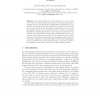Free Online Productivity Tools
i2Speak
i2Symbol
i2OCR
iTex2Img
iWeb2Print
iWeb2Shot
i2Type
iPdf2Split
iPdf2Merge
i2Bopomofo
i2Arabic
i2Style
i2Image
i2PDF
iLatex2Rtf
Sci2ools
ESA
2009
Springer
2009
Springer
Linear-Time Recognition of Probe Interval Graphs
The interval graph for a set of intervals on a line consists of one vertex for each interval, and an edge for each intersecting pair of intervals. A probe interval graph is a variant that is motivated by an application to genomics, where the intervals are partitioned into two sets: probes and non-probes. The graph has an edge between two vertices if they intersect and at least one of them is a probe. We give a linear-time algorithm for determining whether a given graph and partition of vertices into probes and non-probes is a probe interval graph. If it is, we give a layout of intervals that proves that it is. In contrast to previous algorithms for the problem, our algorithm can determine whether the layout is uniquely constrained. This is important for the biological application, where one seeks the true layout of the intervals in a genome. As part of the algorithm we solve the consecutive-ones probe matrix problem.
| Added | 24 Jul 2010 |
| Updated | 24 Jul 2010 |
| Type | Conference |
| Year | 2009 |
| Where | ESA |
| Authors | Ross M. McConnell, Yahav Nussbaum |
Comments (0)

